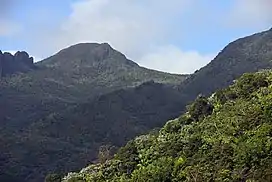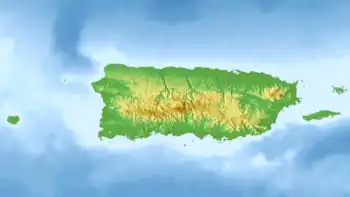Sierra de Luquillo
The Sierra de Luquillo is a mountain range located in the northeastern part of Puerto Rico. Also known as the Luquillo Mountains, these are steep-sided, densely-forested mountains rising to elevations of around 1,075 m (3,527 ft), the highest point being the summit of El Toro, closely followed by that of Pico El Yunque.

| Sierra de Luquillo | |
|---|---|
 | |
| Highest point | |
| Peak | El Toro |
| Elevation | 3,526 ft (1,075 m) |
| Geography | |
 Sierra de Luquillo Location of the Sierra de Luquillo in Puerto Rico | |
| Location | Puerto Rico |
| Parent range | Cordillera Central |
Geography
The mountains of the Sierra de Luquillo were formed by tectonic activity some 37 to 28 million years ago, the island being on the junction between the North American Plate and the Caribbean Plate.[1] The main rock types are pyroclastic rocks, quartzdiorite and contact metamorphic hornfels, with some outcrops of alluvium, basalt and mafic rocks. Nine rivers have their sources in the mountains, flowing downward through steep, rocky and boulder-strewed channels before reach the coastal plains.[2] Easterly winds off the Atlantic Ocean rise and cool as they pass over the mountains, and the ensuing heavy precipitation brings an annual rainfall of 5,000 mm (200 in) on the ridge. The lower slopes are less wet, but the summits are immersed in clouds most of the year.[3]
The Sierra de Luquillo consists of a series of summits linked by a horseshoe-shaped ridge. Running from west to east, some of the peaks include El Toro, El Cacique and El Yunque, joined by a ridge known as Cuchilla el Duque to Pico del Oeste and Pico del Este.[4]
Mountains
The highest summits of the Sierra de Luquillo are the following:[5]
- El Toro - 3,526 ft. (1,075 m)
- El Yunque - 3,461 ft. (1,054 m)
- Pico del Este - 3,408 ft. (1,038 m)
- Pico del Oeste - 3,339 ft. (1,017 m)
- El Cacique - 3,326 ft. (1,013 m)
- Roca El Yunque - 3,270 ft. (996 m)
- Los Picachos - 3,041 ft. (926 m)
- Mount Britton - 3,011 ft. (917 m)
- Cerro La Mina - 2,919 ft. (889 m)
Flora and fauna

The mountains are covered with rainforest, much of it in the El Yunque National Forest. About 240 species of native tree have been recorded in the forest, 88 species being considered rare and about 25 species being found nowhere else in the world. There are about 150 species of fern, and on the trees grow many epiphytes, including about 50 species of orchid.[6] Common trees of the Sierra de Luquillo include Cyathea arborea, Prestoea montana, Cecropia peltata, and Ocotea species while Weinmannia pinnata, Brunellia comocladifolia, and Podocarpus coriaceus are found in the cloud forests of the highest peaks.[7] These dwarf forests occur above the cumulus cloud bases and contain low, dense, species-poor vegetation cover known as elfin or pigmy forest.[8] A research study found that between 1936 and 1988, there were 46 landslides associated with heavy rain in the upper regions of the mountains, and these created gaps that allowed the seeds of pioneering tree species to germinate and ferns such as Dicranopteris pectitnata to proliferate.[9] The forest recovers more quickly after a natural disaster, such as a tropical cyclone, than it does after human activities such as logging, charcoal burning, coffee production or agriculture.[1]
Some 127 species of terrestrial vertebrate have been recorded in the forest,[6] including some rarities and some species endemic to Puerto Rico. The Puerto Rican amazon is critically endangered with fewer than 100 left in the wild. The Puerto Rican broad-winged hawk and Puerto Rican sharp-shinned hawk are both very rare. Many birds visit the island during their annual migrations. The Puerto Rican boa inhabits the lower slopes of the mountains, about 14 species of lizard are found in the forest and 13 species of small tree frogs known as coquí live in the canopy and are endemic to the island.[10]
References
- "Luquillo Mountains, Puerto Rico". Earth Observatory. NASA. Retrieved 27 March 2019.
- "Northeastern Puerto Rico and the Luquillo Mountains". The Luquillo Critical Zone Observatory. Retrieved 27 March 2019.
- Harris, N.L.; Lugo, A.E.; Brown, S.; Heartsill Scalley, T. (Eds.) (May 2012). "Luquillo Experimental Forest: Research History and Opportunities" (PDF). USDA, US Forest Service. Retrieved 27 March 2019.
{{cite web}}: CS1 maint: multiple names: authors list (link) - Murphy, Sheila F.; Stallard, Robert F.; Scholl, Martha A.; González, Grizelle; Torres-Sánchez, Angel J. (2017). "Reassessing rainfall in the Luquillo Mountains, Puerto Rico: Local and global ecohydrological implications". PLOS ONE. 12 (7): e0180987. Bibcode:2017PLoSO..1280987M. doi:10.1371/journal.pone.0180987. PMC 5501619. PMID 28686734.
- "Puerto Rico mountains list | peakery". peakery.com. Retrieved 2021-09-08.
- "Land & Resources Management". El Yunque National Forest. USDA. Retrieved 27 March 2019.
- Olson, D. (1999). Taylor H. Ricketts (ed.). Terrestrial Ecoregions of North America: a Conservation Assessment. Island Press. p. 152. ISBN 978-1-55963-722-0.
- Weaver, Peter L. (1995). "The Colorado and Dwarf Forests of Puerto Rico's Luquillo Mountains". Tropical Forests: Management and Ecology. Ecological Studies. 112: 109–141. doi:10.1007/978-1-4612-2498-3_5. ISBN 978-1-4612-2498-3.
- Guariguata, M.R. (1990). "Landslide disturbance and forest regeneration in the Upper Luquillo mountains of Puerto Rico". Journal of Ecology. 78 (3): 814–832. doi:10.2307/2260901. JSTOR 2260901.
- "Natural Resources: Endangered and Threatened Species". El Yunque National Forest. USDA. Retrieved 27 March 2019.
Further reading
- Weaver, Peter L. (2012). La sierra de Luquillo: los recursos forestales y su historia (PDF). U.S. Departament of Agriculture. Retrieved 3 January 2023.
External links
 Media related to Sierra de Luquillo at Wikimedia Commons
Media related to Sierra de Luquillo at Wikimedia Commons